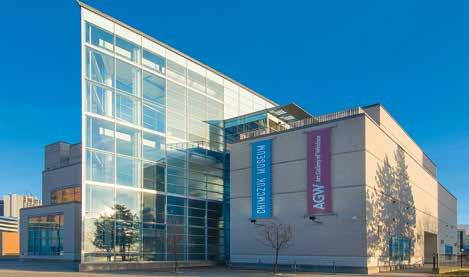
6 minute read
Editorial Viewpoint
editorial viewpoint Art Gallery Survives 20 Years Of Sacrifices By Alan Halberstadt *If you have a comment on this topic, please post it under my column in the CITY section of BizXmagazine.com
Time sneaks up on all of us. Can you believe the AGW will mark a 20 year milestone early next year? (Hopefully when COVID-19 is behind us and city-owned institutions have long been re-opened).
Advertisement
The$24 millionbuilding at 401 Riverside Drive West, opened on February 10, 2001. A retrospective of the modern gallery sparks memories on how it all came together in atangled Windsor fashion.
There were critics of the design regarding too much glass and windows surrounding a spine of grand public stairs, and not enough space to highlight paintings needing protection from sunlight.
Then there were people like Lois Smedick, the now deceased AGW President, who virtually lived on the site, supervising the fine points as it was being built.
She described it as “an architectural marvel both inside and out that is limitless in its potential.”
You can argue whether that lofty standard was met. Certainly the glass ship design is an imposing visual feature across from an international waterway. It is also true that ensuing events exposed structural and planning shortcomings.
“Building woes, as I call them,” muses Mastin.
The finished product engendered astronomical hydro bills and roof and glass sealant leaks that required retrofitting 12 years ago, funded by a Trillium grant.
Not enough foot traffic forced the closure of the gift shop and restaurant. Expectations of free parking, which is part of Windsor’s DNA, kept people away. It still does.
Attendance in 2019 was a dismal 13,883. In 2015, attendance was 26,081, when parking and admission (now $10 for adults) was free while the Chimczuk Museum expansion was being constructed.
Today, the AGW and Chimczuk Museum (MuseumWindsor.ca) share only six free parking spaces as they compete for space with the abutting Adventure BayFamily Water Park.
Considering this,it ishard to deny that the AGW has paid its dues.
“The Art Gallery has given tremendously to the community and has not really been recognized for it,” proclaims Mastin, who deserves heroic acclaim for nine dogged years of inspired leadership.
Mastin rhymes off multiple AGW contributions going back to the origins of the gallery by Founder Ken Saltmarche in Willistead Manor, in 1943. They included the establishment of “Art In The Park” and the move to the present riverfront site on Riverside Drive West in 1975.
Mastin points out the AGW played an essential part in the introduction of casino gambling to Windsor.
In 1993 the Ontario Lottery and Gaming Corporation (OLG) put out an RFP for a site to house an interim casino while it constructed the province’s first permanent casino at 377 Riverside Drive East.
The AGW won the competition under the stewardship of then Board President Ron Ianni, also deceased. He and Executive Director Nataley Nagy cut a sweetheart deal, renting its riverfront location to the province while the gallery was moved to According to Nataley Nagy (pictured) there were amazing exhibits at Devonshire Mall when the gallery was located there. Photo courtesy of the Kelowna Art Gallery.
“We’re the best we can be with the resources we have,” summarizes Catharine Mastin, outgoing Art Gallery of Windsor (AGW) Executive Director.
Devonshire Mall for over six years. That rent was also absorbed by the province in negotiations including big shot cabinet ministers Ernie Eves and Jim Flaherty.
Nagy was just coming on board as Executive Director, from Toronto, and remembers insisting that the AGW be housed somewhere while it was displaced. She asked board members to identify the most popular place in town and the answer came back — Devonshire Mall.
She insisted the gallery’s 4,000 permanent artworks be shipped, displayed and stored at the mall. That was virtual blasphemy to the highbrow old guard patrons, but not to the general public.
Nagy, today entrenched as the Executive Director of the Kelowna Art Gallery in B.C., remembers taking cab rides around Windsor, since she has never driven her own car, and conversations with the “Average Joe”.
“The worst thing you ever did was leave that mall,” was a common refrain she heard. “It was pretty cool. Collection spaces were very visible and accessible. We had amazing exhibitions at that mall.”
Not to mention free parking and built in shopper traffic. In what turned into a real irony, the space at the mall was known as a black box, meaning no windows.
Once the casino vacated the downtown art gallery building, a Carling Brewery warehouse in an earlier life, another controversy arose. Mastin informs us that the old guard had a love-in with the Albert Kahn building and wanted it re-appointed. It so happened that astute art gallery leaders wanted the deal with the OLG in the first place, because the existing building was a shambles.
“It needed a new roof and nobody was going to pay for it,” recalls Mastin.
The demolition die was cast. Architects R&P (Reich+Petch), in a joint venture with Moffat Kinoshita, were hired, with instructions to design a building with a mix of stone, glass and metal to create dramatic views of the Detroit and Windsor skylines, Dieppe Park and the Detroit River, and also to provide large spaces for art and events such as weddings and private parties. Toss in a green roof terrace.
Sixteen years later, along came an entirely new wrinkle — the $5.7 million Chimczuk Museum. After 25 years of acrimony and a court case over the meaning of Joseph Chimczuk’s will, the citywas able to cobble togetherthe money.
All but $405,000 was covered by the interest bearing will of $3.3 million, and a senior government grant to expand the space on the bottom floor, leaving only the top two floors and a mezzanine for the
gallery. The museum — which reported 2018 attendance at 14,717 — opened its doors in 2016.
Voila! Clustered with the ancient, lovable François Baby House at 254 Pitt Street West, Windsor had its long awaited cultural hub. And none of this could have happened without the sacrifice of the AGW, giving up its ground floor and trying to overcome the perception of social distancing.
For the staff of nine, the Chimczuk construction emanating from the main floor “sounded like a tornado going through Beirut,” reveals Mastin, who helped broker a life-saving sale of the AGW building to the city in 2013.
It had become clear that an annual city grant of $450,000 was not nearly enough. The complex deal called for a purchase price of $2.5 million with the city taking over a $1.8 million mortgage plus funding for a laundry list of capital works.
In exchange, the AGW signed a 49 year lease at $1 a year. The city began paying all the utility bills — hydro, gas and water — and took over the tasks of facility cleaning, repairs and maintenance, landscaping and security.
Mastin’s team has kept the AGW debt free for the ensuing seven years on an annual operating budget of $1.3 million, and allowed the gallery to bolster its fundraising,
The Art Gallery of Windsor, hailed by one of its Toronto designers — R&P — as “a paradigm of a modern art gallery as a civic institution, a cultural beacon and architectural icon in the city centre.” Photo by Rod Denis.

sponsorships and program grants, plus outreach to educators and their students.
To make that happen, the unionized staff shrunk from 32, during the Nagy regime, to the current nine.
“We have no archivist, we are so short staffed,” Mastin laments.
I could go on to critique the current exhibitions and laud the depth and breadth of the AGW’s own collections — but I have

run out of space. I suggest readers visit the AGW website (AGW.ca) to see what they offer, and then pay a visit to the gallery itself when the virus pandemic subsides. It’s bound to lift your spirits!
NEWS UPDATE . . . Hailing from the Dunlop Art Gallery in Regina, Jennifer Matotek has been appointed the new AGW Executive Director. She joined the gallery April 15, 2020.










